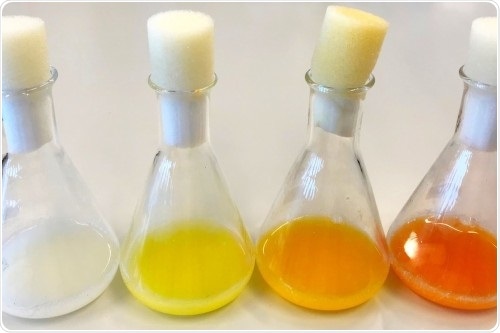A new technique to regulate several genes in engineered yeast cells could pave the way for the highly efficient, sustainable production of bio-based products.

Flasks showing varying carotenoid production by engineered yeast cells. Image Credit: Courtesy of Klaudia Ciurkot.
Published in Nucleic Acids Research by scientists from DSM’s Rosalind Franklin Biotechnology Center in Delft, the Netherlands, and the University of Bristol, the study demonstrates how to unlock the potential of CRISPR for controlling various genes at the same time.
Baker’s yeast, also called Saccharomyces cerevisiae by its full name, is regarded as a workhorse for biotechnology. It has been used for thousands of years to make bread and beer; however, it can be engineered now to synthesize an array of other useful compounds that form the basis of fuels, pharmaceuticals, and food additives.
But it is challenging to achieve maximum production of such products because it requires the complex biochemical networks within the cell to be rewired and extended by introducing new enzymes and adjusting the gene expression levels.
To overcome the challenges of optimising S. cerevisiae cells for bio-production, we explored the use of a less widely employed CRISPR technology based on the Cas12a protein. Unlike the Cas9 protein that is more commonly used, Cas12a can be rapidly programmed to interact with sequences that are responsible for controlling gene expression and easily targeted to many different sequences at the same time.”
Klaudia Ciurkot, Study First Author and EU-Funded Industrial PhD Student, DSM
“This made it an ideal platform for carrying out the complex gene regulation often required for producing industrially relevant compounds. What was particularly exciting for me was that this study is the first to demonstrate Cas12a’s ability to control gene expression in S. cerevisiae and through joint research across DSM and the University of Bristol, we were able to figure out the rules for how this system is best designed and used,” added Ciurkot.
It is hugely exciting that Cas12a has been shown to work so well for gene regulation in the yeast S. cerevisiae, an organism that has huge industrial importance. In addition, the systematic approach we have taken to pull apart and analyse the many difficult aspects of the system, act as a firm foundation for future optimisation.”
Thomas Gorochowski, Study Co-Author and Royal Society University Research Fellow, School of Biological Sciences, University of Bristol
Besides investigating how the Cas12a-based system can best be engineered, the researchers also demonstrated its use for robustly regulating the synthesis of β-carotene—an industrially significant compound used for producing nutraceuticals and food additives.
By demonstrating the capabilities of this system to control the biosynthesis of β-carotene, we have opened the gates to its broader application for other key bio-based products. I cannot wait to see how our system is used to develop more sustainable production platforms for everyday products we all rely on.”
René Verwaal, Study Senior Author and Senior Scientist, DSM
Source:
Journal reference:
Ciurkot, K., et al. (2021) Efficient multiplexed gene regulation in Saccharomyces cerevisiae using dCas12a. Nucleic Acids Research. doi.org/10.1093/nar/gkab529.